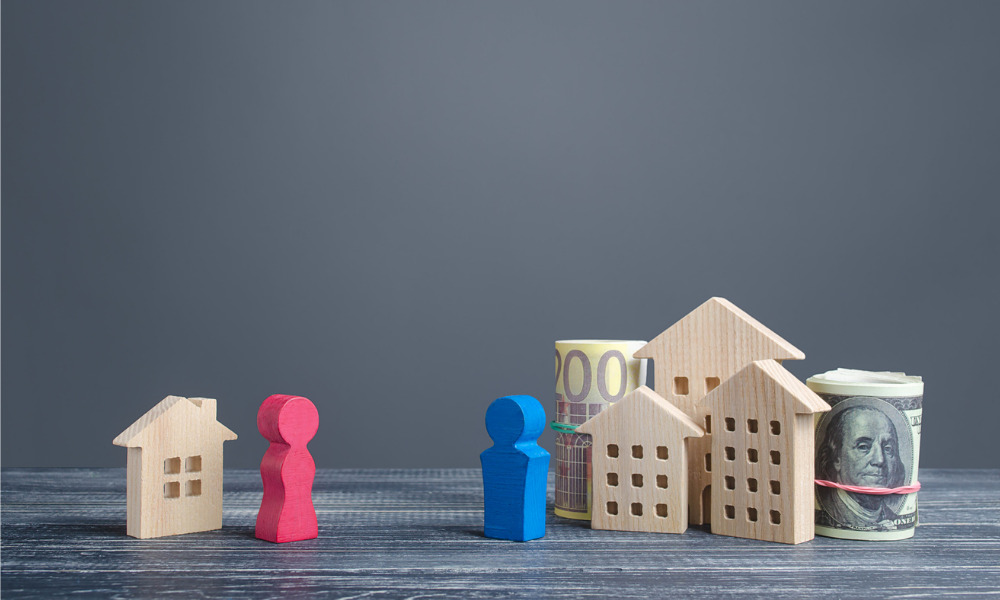Investment properties account for most of the gap

The recent surge in property prices may have widened the gender wealth gap, according to new research by CoreLogic.
Booming prices caused by low interest rates, constricted supply and strong buyer demand have widened the wealth gap between those who own housing and those who don’t, according to CoreLogic’s 2022 Women & Property report. According to the report, women continue to have less overall share of property than men, leaving them potentially disadvantaged by recent wealth gains from real estate.
In January, 26.6% of residential property in Australia had female ownership, compared to 29.9% male ownership. In the 12 months to January, the total value of Australia’s residential market skyrocketed from about $7 trillion to $9.7 trillion, with dwelling prices spiking 22.4%.
Milena Malev, general manager of financial services and insurance solutions for CoreLogic International, said property-price increases may have further exacerbated the gender wealth gap in property ownership.
“Given there’s a high level of equity held in real estate, if you don’t own property, that’s a big source of household wealth and security you don’t have access to,” Malev said. “Property price growth has also vastly outpaced income growth over this time, with the gender pay gap widening in parallel, too.”
The gender pay gap in full-time ordinary earnings rose from 13.4% in November 2020 to 13.8% in November 2021, according to data from the Australian Bureau of Statistics. Malev said a key implication of that widening gap is that, on average, men can save for a home deposit much faster than women.
“The current discrepancy in incomes between men and women could see men save a 20% deposit for the current median dwelling value around a year faster than women,” she said. “That means men are not only accumulating greater wealth from a higher proportion of existing property ownership, but they’re also able to get into the market sooner than women and start that wealth accumulation in a growth market.”
The report also revealed more specific gender disparities in the property market.
“When you delve into the data at a more granular level, such as the proportion of ownership by property or ownership type, some startling new insights have been revealed in this year’s report,” Malev said.
For instance, men are more likely to own houses and women to own units, the report found. Men owned 28.5% of all houses analysed in the report, compared to women’s share at 24%. Women owned 35.2% of units, compared to men’s share of 34.7%.
Eliza Owen, head of research for CoreLogic Australia and author of the report, said that disparity had greater implications for the gender wealth gap.
“Detached houses generally accumulate more value over time than units, with CoreLogic’s Hedonic Home Value Index as of January 2022 showing 10-year annualised growth rates in Australian house values was 6.2% per annum, compared with 4.1% per annum for units,” Owen said. “What this means is that house owners accrue a lot more value over time compared to unit owners. The nominal gains in the median Australian house value over the past decade totalled around $340,000, compared with $197,000 for the median unit gain.”
Read next: What’s impacting consumer credit demand?
The report also found that investment properties accounted for most of the gender wealth gap in real estate. Men own 36.4% of all investment properties analysed, while women own 29.1%. That disparity amounts to about 105,500 more investment properties owned by men than women.
“Our data suggests that around 70% of the discrepancy between male and female residential property ownership in Australia is accounted for by ownership of investment properties,” Owen said. “The proportion of investment properties owned by men was also higher than the rate of joint male and female ownership of investment properties (34.5%). While it is hard to say what drives this discrepancy, it is notable that men have higher representation in property as an investment. We don’t know whether this is a reflection of multiple-property ownership being more common among men, or if it’s a response to affordability constraints – such as a rent-vesting strategy – but this seems to drive most of the gap in residential property ownership.”



